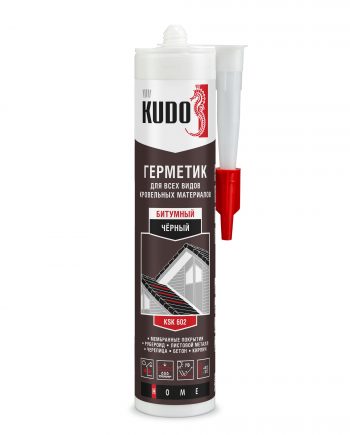Silicone sealant for aquariums and show-windows
SKU: KSK-200

KUDO® High-quality silicone sealant with acetoxy curing system is intended for bonding glass in aquariums, terrariums and for sealing glass, ceramic, stainless steel, anodised aluminium, enamelled surfaces, wood, PVC and other materials.
Intended for indoor and outdoor works, can be used in rooms with high humidity to seal joints around shower cabins, bathtubs, sinks, swimming pools; for sealing joints when installing sanitary equipment, waterproofing surfaces, sealing joints between tiles.
Has high operating characteristics: forms a durable waterproof joint, does not discolour and does not accumulate dust, resistant to most detergents and cleaning agents, UV, weather and temperature changes, and almost all aggressive conditions. Thixotropic, does not flow or drip down the joint. Flexible for a long time, withstands up to 20% deformation while in use. When sealing aquariums up to 150 litres, no additional structural reinforcement is necessary.
Benefit
- Resistant to UV radiation, cleaning agents and detergents.
- Resistant to impact and vibration, withstands up to 20% deformation.
- Has a wide operating temperature range: from –40°C to +180°C.
- Skin formation time is 10-20 minutes. Curing rate – 2 mm per day (at 23 °C and 50 % humidity).
- A cartridge covers 20-22 running meters with a roll diameter of 4 mm.
Technical Information
| Colors | Transparent KSK-200 |
|---|---|
| Adhesive/Sealant base | Silicone |
| Type | Sealants |
| Content | 280 ml |
| Storage | Store in tightly closed original packaging at temperatures from +5°C to +25°C in a dry place. During transportation, freezing down to -20°C is allowed for a total duration of not more than 30 days. |
| Shelf life | 18 months |
How to use
- It’s recommended to apply the product at an ambient temperature from +5°C to +40°C. The temperature of the sealant should be +20°C… +25°C.
- Apply the sealant to clean, dry, degreased surfaces.
- Protect surfaces with masking tape to ensure an accurate application.
- Cut off the tip of the cartridge above the screw thread, screw on the nozzle, unscrew the nozzle cap and cut off the nozzle diagonally (at an angle of 45°) according to the diameter of the joint width.
- Use a cartridge-operated gun for application.
- Smooth down the sealant in the joint with a wet putty knife. Remove the masking tape immediately after smoothing.
- Remove the sealant from tools and surfaces using a solvent (white spirit, or acetone) before the sealant has cured.
- Remove cured sealant using mechanical methods.
Note! The sealant may be tinted over time if blue chemicals are added to the aquarium!
It is not recommended to use the sealant when dealing with natural stone (marble or granite), metal surfaces prone to corrosion (lead, copper, zinc, or brass), or concrete, cement, plastered surfaces, as well as when working with mirrors. Do not paint over!








